As history has shown, landing on Mars is not easy. Not counting Curiosity, 16other spacecraft have tried to reach the Red Planet's surface. Only six succeeded.
If you want to start an argument among space-history buffs, ask them, "Which spacecraft was the first to land on Mars successfully?"
Most would answer "Viking 1, in 1976". (Those really into it will say, "Viking 1, which touched down on Chryse Planitia at 5:12 a.m. PDT on July 20, 1976." Without question, Viking 1 and its twin, Viking 2, set the bar very high for all future Martian landings. They were the first (and, so far, the only) spacecraft to search for life on another solar-system object.
But a minority would counter that the "First on Mars" bragging rights should go to Mars 3, a Soviet-era probe that made its descent five years earlier. By all accounts, the spacecraft landed intact and began transmitting television images when, mysteriously, all communications ceased after 20 seconds. The exact cause was never determined (or at least made public). Maybe the lander malfunctioned — a fierce global dust storm raged at the time — or maybe the problem lay with its signal-relaying craft flying by high above the landing site.
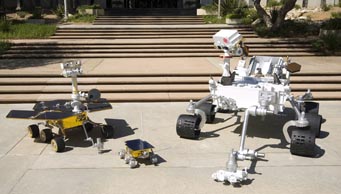
Weighing about a ton, the rover Curiosity (right)) is far larger than its predecessors Spirit and Opportunity (left)), which reached Mars in 2004; and tiny Sojourner (center)), which landed in 1997.
NASA / JPL
We've learned much about the surface of Mars since then, and Curiosity is the latest in a string of Martian landers (and landing attempts) that stretches back more than 40 years. Yet, of the 16 prior spacecraft destined for the Martian surface, only six — not counting Mars 3 — were complete successes, and all those bore the U.S. flag.
Even NASA has had its share of failures. I'll never forget the looks of crushing disappointment on the young faces of scientists for NASA's Mars Polar Lander, which went silent after beginning its descent through the planet's thin atmosphere. Equally puzzling is the fate of the twin Deep Space 2 probes, which apparently reached Mars without incident but never transmitted anything to those waiting back on Earth.
If you broaden the inspection to include all missions to Mars, the statistics are even starker: of NASA's 20 Mars-bound spacecraft launched since the 1960s, six failed. Of 46 launched by all countries, 26 failed — a success rate of just 42%.
Click here to see a list of all Mars missions to date.
As Spanish philosopher George Santayana famously wrote a century ago, "Those who cannot remember the past are condemned to repeat it." With those words in mind, here is a recap of the spacecraft that preceded Curiosity's quest to reach the Martian surface. Links are to each craft's entry in an excellent database maintained by the National Space Science Data Center.
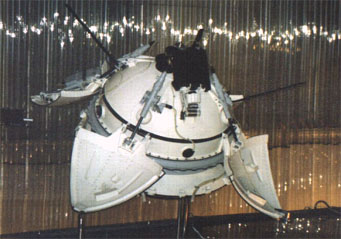
A model of the capsule for the Soviet Union's two attempts to land on the Red Planet in 1971. Mars 3 reached the surface safely (five years before the Vikings' arrived) but mysteriously fell silent about two minutes after touchdown.
NSSDC
Mars 2 (1971): This mission consisted of a large orbiter with an attached lander. As was typical of early Soviet interplanetary efforts, the spacecraft were massive: the spherical landing capsule was 4 feet (1.2 m) across and weighed nearly a half ton. Its scientific goals were likewise ambitious: on board were two TV cameras and instruments to measure meteorological conditions, the thin atmosphere's composition, and surface characteristics. The descent module detached as planned, but a malfunction occurred and its parachutes did not deploy. The crash site has not yet been spotted by subsequent orbiters.

This partial image was transmitted by the Mars 3 lander from the planet's surface in 1971. But is it nothing more than radio noise?
Russian Academy of Sciences / Ted Stryk
Mars 3 (1971): Five days later, a second craft detached from its orbiter and headed toward the surface. Both parachutes worked, as did a braking rocket, and the heavily cushioned craft thumped onto Terra Sirenum at 45° S, 158° W. Within 90 seconds, Mars 3 had opened its four petal-shaped covers and begun transmitting TV images to its orbiter. But everything stopped after 20 seconds, and only a single noisy image reached Earth. To this day it's unclear whether the orbiter or the lander failed — it surely didn't help that a global dust storm was raging on Mars at the time of the landing.
Mars 6 (1974): In July and August of 1973, the Soviet Union launched two orbiters and two landers toward the Red Planet. By the following March, Mars 6's landing capsule detached from its flyby craft and plunged into the atmosphere at 3½ miles per second. Everything was going well, and the craft transmitted some data for about four minutes during its descent toward the Margaritifer Sinus region of Mars. But radio contact was lost when the lander was in "direct proximity to the surface". Analysis suggests the rocket system might have failed.
Mars 7 (1974): After an uneventful 7-month interplanetary cruise from Earth, Mars 7 ran into trouble once it arrived at its destination. Due to some malfunction, possibly due to a faulty computer chip, the landing capsule separated from its main craft 4 hours too early and missed the planet by about 800 miles.
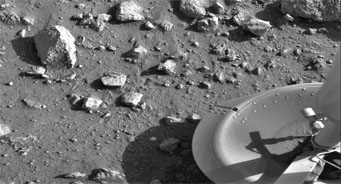
Mars, at last! This is the first image sent by NASA's Viking 1 lander, taken just minutes after the spacecraft touched down on July 20, 1976. One of the lander's three footpads is at right.
NASA / JPL
Viking 1 (1976): NASA had never attempted an interplanetary mission as complex as this billion-dollar effort involving twin orbiters and landers. Equipped with a long sampling arm and a suite of experiments to sample the atmosphere and analyze the soil (including three biological tests), Viking 1 reached a floodplain known as Chryse Planitia on July 20th. (It was supposed to land on July 4th, to mark the American bicentennial, but concerns over landing-site safety forced a two-week delay.) Despite its complexity, Viking 1 performed very well. One biology experiment indicated that metabolic activity was occurring in its test samples, but that was negated by results from the other two experiments and from a test for organic matter. The debate over those results continues, though most researchers agree that highly oxidizing inorganic compounds in the surface led to a false positive.
In any event, Viking 1's lander continued to transmit data until November 13, 1982 — two years after its orbiter failed. In fact, the lander continued to function even as NASA sought to end the mission, causing space buffs led by Stan Kent to raise private contributions to "feed a starving robot". Their Viking Fund eventually funneled more than $100,000 to NASA to extend mission operations and data analysis.
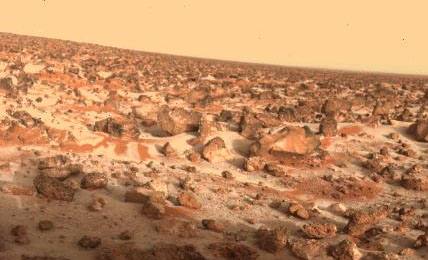
On May 18, 1979, the Viking 2 lander awoke to find its landing site on Mars's Utopia Planitia dusted with a thin water-ice frost that had accumulated overnight. Mote the rocky terrain — hardly the smooth, sandy landscape that had been expected. The orange haze in the sky is due to microscopic dust suspended in the thin Martian atmosphere.
NASA / JPL
Viking 2 (1976): The second Viking lander safely reached Mars seven weeks after its twin. Both vehicles had used radar-aided braking rockets — essentially the same technology adapted for Curiosity's final descent. However, the first views of Viking 2's landing site at Utopia Planitia came as a shock to waiting scientists: instead of the expected gently rolling sand dunes, the place was covered with rocks — big rocks. (The lander's underbelly had only 10 inches of clearance.) Because it was situated quite far from the equator (48° N), Viking 2 experienced much colder climatic conditions and even photographed coatings of frost on the surroundings. Fortunately, as with Curiosity, the Viking landers were powered and kept warm by plutonium-powered generators. Although it didn't endure as long as its twin did, Viking 2 operated until April 1980, when its batteries finally failed.
Mars 96 (1996): A beefy, 3-ton spacecraft, Mars 1996 was an orbiter equipped with 22 instruments to study the planet's surface, atmosphere, magnetosphere, and deep space. It also bore two small independent autonomous craft and two penetrators designed to plunge deeply into the Martian surface. But it never had a chance to use any of that — after getting into Earth orbit, the rocket that was supposed to propel it to Mars failed, and everything crashed back to Earth along the Pacific coast of South America.
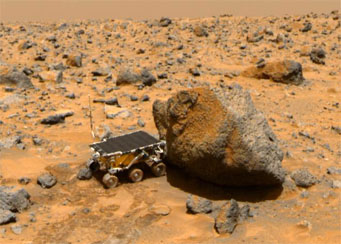
In 1997, after eschewing the Red Planet for two decades, NASA returned to the planet's ruddy surface with Mars Pathfinder. Here the small rover Sojourner is studying a large volcanic rock nicknamed Yogi.
Kelly Beatty
Mars Pathfinder (1996): Amazingly, after their stunning Viking successes, NASA managers actually shunned Mars for two decades — going so far as to forbid agency scientists from actively pursuing new missions to the Red Planet! But administrations and attitudes changed, leading to a triumphal return to the Martian surface with Mars Pathfinder and its cute six-wheeled rover, Sojourner. The craft landed in the ancient Ares Vallis floodplain amid rocks and sand that evoked impressions of the American Southwest, and mission was an Internet sensation followed by millions worldwide. The whole point of the mission was to determine water's role in shaping the Martian landscape. Soil samples proved to have compositions much like those at the Viking sites, and the landing site's rocks revealed various igneous and perhaps sedimentary compositions.
Mars Polar Lander (1999): With NASA managers eager to "follow the water" on Mars, they dispatched a lander to touch down less than 600 miles from the south pole, on layered terrain (alternating beds of ice and dust) near the edge of the planet's carbon-dioxide ice cap. Mission "firsts" included a camera that would record continuously the scene below from 5 miles up until touchdown, a Russian-built experiment to measure atmospheric dust and haze, and a miniature microphone to record any sounds on the Martian surface. But the final communique from Mars Polar Lander (MPL) came just before its atmospheric entry and descent. No one heard from it after that, and no one knows for sure what happened — though its suspected that the descent engines fired prematurely.
Deep Space 2 (1999): Two little-known hitchhikers accompanied MPL to Mars. Involving high-risk, cutting-edge technology, the twin Deep Space 2 probes were designed to plunge headlong into Mars at roughly 400 miles per hour. The top part of each 8-pound penetrator would remain on the surface, while the forebody buried itself up to 3 feet below ground level. A small drill would then extend to the side and draw a tiny sample inside, where it would be analyzed for the presence of water ice and water-bearing compounds. Alas, an orbiter passing overhead failed to detect signals from either probe, and the cause of their failure remains a mystery.
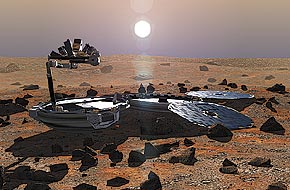
Although it weighed just 30 kg, the clamshell-like Beagle 2 was well equipped to study Martian rocks and dust. Its planned landing site was Isidis Planitia, an ancient impact basin.
Beagle 2 (2003): Equally heartbreaking was the inexplicable loss, four years later, of a British-built lander called Beagle 2 (named to honor the HMS Beagle, on which Charles Darwin voyaged around the world in the 1830s). This lander was the brainchild of planetary scientist Colin Pilinger (Open University), who wanted to continue the search for Martian life, past or present, begun by the Viking landers. Pilinger famously stumped around the U.K. to raise funds for his project, even enlisting the support of artists and musicians.
Ingenious in many respects, Beagle 2 included a "mole" that could inch across the surface and burrow into the ground. Once returned to the main craft, suitable samples would be heated and analyzed for their ratios of carbon isotopes. The 73-pound (33-kg) lander hitchhiked to the Red Planet as part of the European Space Agency's Mars Express mission. But when landing day came on Christmas Day, Beagle 2 failed to contact Mars Odyssey, the NASA-built orbiter that was to serve as its radio relay. Powerful radio telescopes on Earth also failed to detect its transmissions.
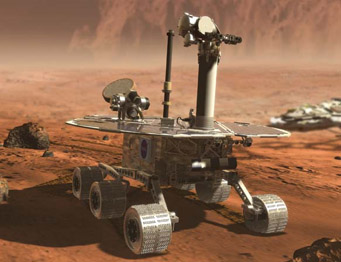
With a mass of roughly 400 pounds (180 kg), each of NASA's twin Mars Exploration Rovers carried a suite of five instruments, collectively called Athena, and an abrasion tool for exposing fresh surfaces on rock faces.
NASA / JPL
Spirit (2004): After these crushing losses, much was riding on NASA's twin Mars Exploration Rovers. Looking like mutant insects, with six wheels and swept-back solar-cell "wings", they were built to seek evidence of water-influenced surface chemistry and to greatly extend the few limited-range sorties undertaken by Sojourner. Boy, did they! Designed for a nominal mission of 90 Martian days (sols), they became the Energizer Bunnies of Martian landers. Spirit arrived in January 2004 and puttered around the interior of Gusev Crater for six years — despite a right-front wheel that seized up in 2006. In mid-2009 Spirit got stuck in a drift of soft sand, then a second wheel failed. By then Spirit had covered an incredible 4.8 miles (7.7 km). Its handlers back on Earth valiantly tried to rescue their charge but finally were forced to bid Spirit adieu in May 2011.
Opportunity (2004): Eight years after landing on Meiridiani Planum, across which water once freely flowed, Opportunity continues not just to survive but to function well. As of this week, the rover's odometer reads 21.5 miles (34.6 km). It continues to gambol around the rim of Endeavour crater, a huge crater (by rover standards) that's 22 miles across. "Oppy" reached Endeavour in August 2011 after a 3-year, 13-mile trek.
You could write a book about the many scientific successes of these rovers (and some have). For me, the one that stands out is the discovery of "blueberries" — little round balls of the iron-oxide mineral hematite. These little baubles could only have formed if the ground had been saturated with water for a long period. You can learn much more about Spirit and Opportunity at NASA's Mars Exploration Rover website.
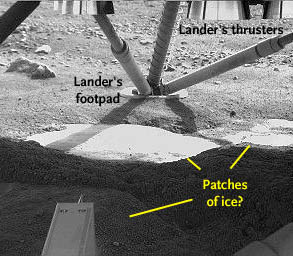
The Robotic Arm Camera on NASA's Phoenix Mars Lander captured this image underneath the lander, showing smooth surfaces cleared from overlying soil by the rocket exhaust during landing. The two level, overexposed surfaces in the center, plus the shadowed one at lower left, were scoured clean by rocket exhaust and are probably exposures of water ice.
NASA / JPL / Univ. of Arizona / Max-Planck Inst.
Phoenix (2008): The most recent spacecraft to reach the Martian surface is among the most successful — and yet most perplexing — ever undertaken by NASA. Phoenix set down on a huge north-polar plain called Vastitas Borealis atop what scientists expected to be a vast, thinly buried slab of water ice. Within days of landing, it was clear that Phoenix had landed on exactly that. Yet, despite weeks of clawing at the ice-rich surface with a specially designed robotic arm, Phoenix had chronic difficulty stuffing samples of the clumpy dirt-ice mix into its experimental chambers. Moreover, NASA engineers knew the ensuing Martian winter would probably bury the spacecraft with carbon-dioxide snow, and that seems to be what happened. After failing to hear from the spacecraft, the mission ended about 5½ months after Phoenix's arrival.
Curiosity (2012): The most complex interplanetary rover ever built reached Mars and dropped onto the floor of 96-mile-wide Gale crater. In September 2014, after studying rocks near its landing site for two years, Curiosity reached the base of its primary objective — officially named Aeolis Mons but informally dubbed Mount Sharp — whose layers should reveal key details of the Red Planet’s history.
What will space historians write about Curiosity? Certainly that it was ambitious, technologically challenging, and expensive. But that's the nature of Martian exploration these days. The easy missions were accomplished decades ago. Now it's time to dig deeper into the complex, fascinating history of our ruddy interplanetary neighbor. Curiosity, now well into its mission, hopes to do just that.
 0
0
Comments
You must be logged in to post a comment.